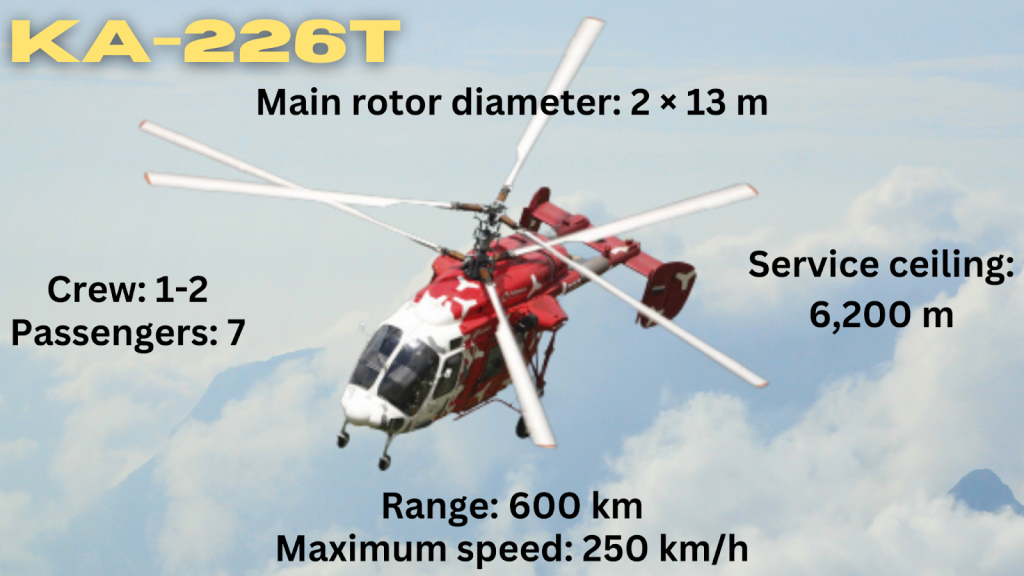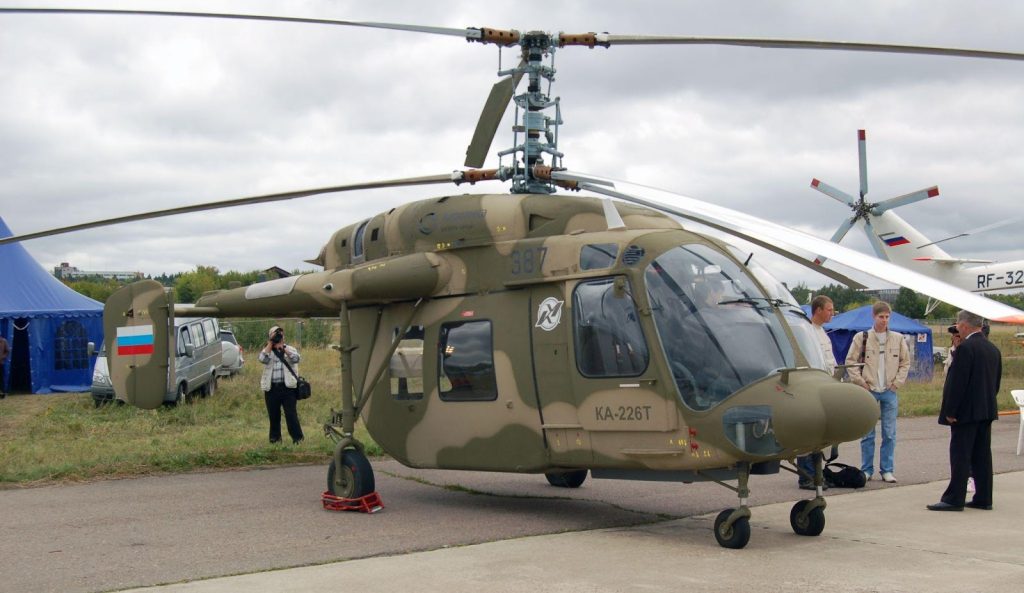By Aritra Banerjee
From the shores off of Mumbai, the hills of Arunachal Pradesh to Kochi, recent chopper crashes have put India’s entire helicopter fleet under tight media scrutiny. The topic of replacement of old Cheetah and Chetak aircraft has come to the fore, too. Russian-built Kamov Ka-226T has been a favourite in India to phase out these ageing aircraft. Codenamed Hoodlum, this aircraft is equipped with state-of-the-art features. Experts suggest that by design, it would be ideal to operate in the High Himalayas.
The joint-production of the aircraft between long-time defence partners India and Russia would open multiple avenues for the local defence sector as well.
One Chopper, Multi-Utility
The Ka-226T light multi-purpose helicopter was most recently showcased by Russian Helicopters Holding, a subsidiary of Rostec State Corporation, at the international IDEX exhibition in Abu Dhabi. This rotorcraft boasts impressive manoeuvrability and versatility thanks to its modular design. The Ka-226T is a gas turbine helicopter that has been modernised with upgraded design features, reducing its weight and improving its flight performance. Its twin-rotor coaxial design also simplifies piloting techniques, ensuring high manoeuvrability and stability. This is true even for high wind loads, both in flight and during landing. Unlike conventional choppers, coaxial helicopters are also more resistant to damage from enemy fire. The Ka-226T can fly up to 6,500 meters above sea level and carry a payload of up to 1,500 kg, with a maximum flight weight of 3,800 kg.
Its payload and flight range has been enhanced, making it ideal for cargo, passenger and service personnel transport. It also fits the bill for patrol, monitoring, search and rescue (SAR), and casualty evacuation (CASEVAC) operations. Operators can convert the passenger board into an air ambulance or cargo carrier in 30 minutes. The airborne transport version can carry up to seven passengers, while the medical cabin can accommodate two patients on stretchers and two paramedics. Operators can also install cargo platforms, crane installations, and aerial chemical work sets instead of a suspended cabin.
The aircraft’s unique “flying chassis” concept enables suspension modules for various equipment to be placed behind the cockpit, allowing operators to have one carrier helicopter with several interchangeable module options.
A localised upgrade, designed especially for India, features the Ka-226T sporting improved aerodynamics, cockpit ergonomics, and modified fuselage geometry. Its main rotor column has been modernised. A mechanism for folding the blades has been added, making it ideal for ship versions. The compact helicopter can fly over vast water surfaces and be easily based on ships. Its crash-resistant fuel system and digital avionics system with a display indication make it safer and more reliable.
The National Center for Helicopter Engineering is conducting flight tests of a prototype of the upgraded Ka-226T and ground tests of individual rotorcraft units. With its advanced capabilities and versatile design, the Ka-226T is set to become a leading choice for operators seeking efficiency, flexibility, and reliability in their helicopter fleets.
Developed For India

IADB learned from a highly placed source that it can be assumed that “the successful launch and – no doubt, the successful progressive implementation – of the AK203 production project in India – should demonstrate the need to transition to the launch of the Ka-226T program. The program envisages the maximum level of localisation for such a complex aeronautical system.”
“The project is fully prepared. The helicopter in the agreed technical form is ready for production. It was demonstrated in 2021 at the MAKS and ‘Army’ exhibitions in the Russian Federation, and the world premiere of the helicopter took place at Dubai Airshow 2021,” the source added.
Apart from India, for which Ka-226T has been developed, the Russian chopper has also caught the eye of its geopolitical arch-rival China. Saudi Arabia, too has reportedly shown interest in the helicopter. Many countries with mountainous terrain are expected to benefit from having the Ka-226T. The helicopter has been described as ideal for Indian military applications at high altitudes, especially now amidst the backdrop of Sino-Indo tensions along Eastern Ladakh and Beijing’s interest in getting its hands on the helicopter.
The Ka-226T touts several distinguishing features ranging from a coaxial scheme, to increased thrust-to-weight ratio and rate of climb, to increased safety in flights over mountains and sea. The chopper sports two engines, which are known to improve flight safety over mountainous terrain sorties above the sea. If one engine fails, the flight can continue on the second.
The helicopter has no tail rotor meant to improve operational safety as “it will not hurt people or objects”. Furthermore, the compact design of the chopper bolsters its ability to land on small areas in the mountains. Boarding and disembarking of people are carried out faster. It may be pertinent to note that since India already has experience operating the Indian Navy’s Kamov coaxial helicopters, it is expected to be able to seamlessly adapt to this helicopter technology.
Crossing Localisation Hurdles
Prior to Aero India 2023, reports suggested that the talks between New Delhi and Moscow were almost frozen due to India’s dissatisfaction with the level of localisation proposed by the joint venture (JV). However, Moscow’s Indian partners have already been provided with revised proposals for the localisation of helicopter production in India, with a localisation level of 70% being proposed. Deputy Director of the Russian Federal Service for Military-Technical Cooperation, Vladimir Drozhzhov, confirmed this development on the sidelines of Aero India 2023.
State-owned Hindustan Aeronautics Limited’s (HAL) Chairman and Managing Director, C.B. Ananthakrishnan, too, was asked about the reported freeze. He stated that HAL is prepared to begin work on the project as soon as it is approved. The Indian state-owned aerospace and defence company also confirmed no conflict of interest between Russia and India over the joint production program of Ka-226T light helicopters.
In addition to the joint production program, Indian military officials are also considering purchasing already assembled Ka-226T helicopters from Russia. Drozhzhov indicated that a decision on this matter is expected soon from the Indian side. The manufacturing workshop for the Ka-226T helicopter is located at HAL’s helicopter facility in the city of Tumakuru, Karnataka. Initially, the plant was proposed to supply 200 helicopters for the program.
The Ulan-Ude Aviation Plant (U-UAZ) in Buryatia, which will participate in the Ka-226T project in Russia, has a rich history. It has produced MiG-27 combat aircraft and played a significant role in the transfer of technology (ToT) for the license production of MiG-27 Bahadur by HAL in the 1980s.

HAL Ready To Manufacture Ka-226T & LUH Helicopters In Same Facility
India’s largest chopper manufacturing facility, located in Karnataka’s Tumakuru district was recently inaugurated by Prime Minister Narendra Modi. It is now ready to commence production of Russian Kamov Ka-226T light helicopters, along with the locally manufactured Light Utility Helicopter (LUH), with an annual production capacity of 60 units, according to HAL.
The Indian Air Force (IAF), Army, and Navy have expressed interest in replacing approximately 400 Vintage Cheetah and Chetak light helicopters purchased in the 1960s. As a result, orders have been divided equally between Ka-226T and LUH.
Although there have been calls in India to allocate all 400 units to LUH since it is a locally made helicopter, both Ka-226T and LUH are in the same class. Ka-226T is a twin-engine utility helicopter, unlike LUH, which is single-engine. This makes the former safer to operate in high altitudes and provides more power, often required in high altitude areas (HAA).



